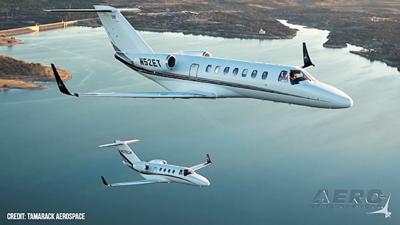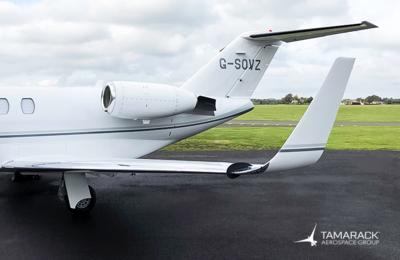Sun, Nov 07, 2021
Says 2018 Citation Crash Report Self-Contradictory
Tamarack has disputed the findings of probable cause in the NTSB’s final report of a 2018 crash of Cessna Citation N525EG.

The Board faulted Tamarack’s Active Winglet system, alleging that the crash was the result of an “asymmetric deployment of the leftwing load alleviation system for undetermined reasons.” Tamarack states that forensic evidence collected in the course of the investigation proved that the load alleviation was indeed functioning correctly and deploying symmetrically upon impact. Additionally, the company points out a number of inconsistencies and omissions in the official report.
First, they note that the NTSB’s final report states the aircraft was rolling at 5 degrees per second, when the autopilot automatically disconnected at 30 degrees of bank, not, as a functioning Citation autopilot would, at 45 degrees of bank or 10 degrees per second. They note the failure of the investigation to account for the premature autopilot disconnect and inappropriate automated response for an excessive bank condition.
Tamarack notes their full cooperation throughout the investigation, but says the NTSB published a revised Factual Report, then the Final Report, without taking into consideration alternative causes.

Their supplemental data paints a picture of target fixation on the part of the agency, as if the concept of an active aerodynamics system was so clearly the cause of the crash that it precluded serious effort into any other avenue. They recall that the Final Report includes information that the pilot was able to carry out some corrective action late in the flight at very high speeds, but fail to make mention that, if there were an active winglet failure, then the aircraft would have been easier to recover at slower speeds. They point to this as a possible lead in understanding the true source of the incident.
They note with sadness the casualties of the accident, and wish to ascertain everything possible that they may prevent future loss of another member of their Citation family.
More News
From 2023 (YouTube Version): Legacy of a Titan Robert (Bob) Anderson Hoover was a fighter pilot, test pilot, flight instructor, and air show superstar. More so, Bob Hoover was an i>[...]
Get The Latest in Aviation News NOW on Instagram Are you on Instagram yet? It's been around for a few years, quietly picking up traction mostly thanks to everybody's new obsession >[...]
Aero Linx: B-52H Stratofortress The B-52H Stratofortress is a long-range, heavy bomber that can perform a variety of missions. The bomber is capable of flying at high subsonic spee>[...]
Altimeter Setting The barometric pressure reading used to adjust a pressure altimeter for variations in existing atmospheric pressure or to the standard altimeter setting (29.92).>[...]
"Knowing that we play an active part in bettering people's lives is extremely rewarding. My team and I are very thankful for the opportunity to be here and to help in any way we ca>[...]
 Classic Aero-TV: Remembering Bob Hoover
Classic Aero-TV: Remembering Bob Hoover ANN FAQ: Follow Us On Instagram!
ANN FAQ: Follow Us On Instagram! ANN's Daily Aero-Linx (05.15.24)
ANN's Daily Aero-Linx (05.15.24) ANN's Daily Aero-Term (05.15.24):Altimeter Setting
ANN's Daily Aero-Term (05.15.24):Altimeter Setting Aero-News: Quote of the Day (05.16.24)
Aero-News: Quote of the Day (05.16.24)




